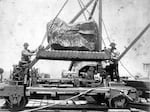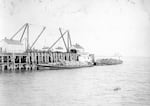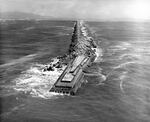“There are hundreds, probably thousands of shipwrecks out here,” said Christopher Dewey.
Since the 1800s, the Graveyard of the Pacific has claimed over 2,000 ships and hundreds of lives. This waterway is the Columbia River Bar, where the Columbia River collides with the Pacific Ocean, and explodes. The 1,200-mile river and mighty Pacific meet with the force of a firehose, and weather conditions can dramatically shift in minutes. Sailors can be caught off guard in a storm with hurricane force winds and waves towering over 40 feet.
Related: Columbia River Bar Pilots
A few miles from the bar, in Astoria, Oregon, Christopher Dewey works inside the Columbia River Maritime Museum. He's chipping away at the seemingly unending project of officially identifying different shipwrecks in the region.
Dewey and a modest, weekly team of volunteers are engulfed by the library's collection spanning tens of thousands of objects, photographs and volumes that together tell the centuries-long history of maritime trade in the area.
As president of the Maritime Archeological Society, Dewey helps anchor some of the discrepancies of local shipwrecks, which have floated around the oldest settlement west of the Mississippi for decades.
"A lot of good stories, but the documentation proves otherwise," Dewey said. He sees their job as putting a period at the end of the story and closing the chapter of shipwrecks along the Oregon Coast.
The legacy of the Graveyard of the Pacific is never far away in Astoria. "You can't walk around and probably not walk over a piece of a shipwreck," Dewey said.
The Columbia River Bar is one of the most deadly waterways in the world, and yet sailors have tried to cross it for centuries.

A ship at the Columbia River Bar.
Columbia River Maritime Museum.
Shifting Shipwrecking Sandbars
Imagine captaining a ship in the 1800s. You've endured all the wonders of a Pacific Northwest winter — pummeling rain, thrashing wind and thick fog — all the while avoiding the rocky coastline. That's when you encounter the Columbia River Bar, where the Columbia River and the Pacific Ocean smash together.
The Columbia River, the largest waterway the Pacific Northwest, collects a massive amount of sediment as it rolls down stream. But it does not gently flow out to form a delta, which happens when most rivers meet large bodies of water. Here, the silt, sand and debris sink and create a shallow bar, which can move in a half-a-year or even a month. Even just shifting a few feet could be disastrous for foreign vessels.
"If a mariner was approaching the river with a 4-year-old chart — good luck," said Jeff Smith. He's the curator at the maritime museum and said, even with the risks, more and more ships came to the bar throughout the 1800s.
The waterway opened the region to the wider world, and the potential financial reward made the gamble worth taking. As the ships came, it became clear the passageway needed to be safer if the region were to thrive.
But was it possible to tame the Graveyard of the West?
Sailors in the area became vital. Using local knowledge and mastery of seafaring, they knew best how to make it through the treacherous waterway alive. These mariners were hired to guide ships through the passage as bar pilots. They were officially chartered 13 years before Oregon became a state.
By the late 1890s, a lighthouse was built at Cape Disappointment, as was a precursor to the coast guard to patrol the area. But none of this changed the shifting, shipwrecking sandbars. The Army Corps of Engineers decided to alter the flow of the river.
The Corps built jetties at the mouth of the Columbia, which was like putting a nozzle on the river, rushing the water out like a hose on a blast setting. The river current speeds up and all the silt and debris now spill further down the Pacific. It prevents clogging the mouth of the Columbia.

Workers load a boulder on a rail cart.
Columbia River Maritime Museum
The Great Jetties Of The Pacific Northwest
It's hard to imagine the enormity of such a project at the time.
The south jetty is made up of around 9 million tons of rock. That's like moving 20 aircraft carriers, 6 1/2 miles out into the ocean — in 1885.
Workers quarried rock upstream, loaded the boulders onto barges, then rail carts. The train moved on a railway stretching out into the Columbia River Bar, before finally dumping them in the river. The Army Corps created three jetties, and the project took 50 years to complete.
Every year, the Army Corps dredges up around 3.5 million cubic yards of sediment to help clear the channels forged by the jetties. With more predictable routes, commerce boomed.
Today, the Columbia River Bar is the gateway to over $24 billion of yearly trade.
But this waterway is relentless. After years of pounding, the jetties are showing their age and need to be fixed. The Army Corps is repairing the jetties — yet even with modern equipment, it's a seven-year project.
Although bar pilots can now board commercial ships by helicopter and sailors can use sophisticated GPS. This waterway is still the Graveyard of the Pacific.
It's a small reminder of how even in our modern age we're still no match for such a force of nature.
“The river is the river and the ocean is the ocean,” said Jeff Smith. “We’ve made it safer, we’ve made it more predictable, but it’s never tamed.”







